Journal of the Door County Land Trust



Provide the basic creature comforts of food, water, and shelter to the critters in your yard.
FOOD: It’s for the Birds
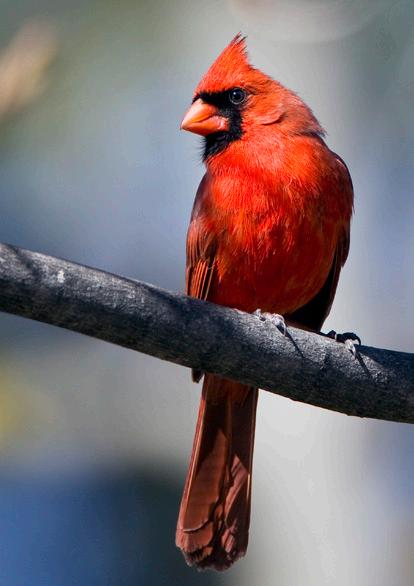
•Place bird feeders about 10 feet from shrubs or other places where cats might lurk.
•Keep seeds dry. If seeds get wet, dump out and start fresh to prevent mold growth.
•Clean feeders every couple of weeks with a 2:1 mixture of hot water and distilled white vinegar. Rinse and dry thoroughly before refilling.
•Choose black oil sunflower seeds over blends. Blends often contain “filler” seeds that birds generally won’t eat.
•When temperatures drop below freezing, provide higherfat foods like peanut butter and suet for hungry birds.
•Birds are the only wildlife you should feed artificially. Provide natural food sources for other animals by planting native trees and shrubs that have winter berries.
WATER: Get that Chipmunk a Drink! When ponds and streams freeze, it can be hard for wildlife to find a drink. Put out fresh water with these tips to keep it frost-free:
•Install an electric or solar-powered fountain or “water wiggler” in your birdbath, or invest in an electric birdbath heater. Easier still, simply place your pan in a sunny spot and fill with fresh, warm water as needed.
SHELTER: Leave the Leaves Offer wildlife protection from harsh weather and predators, naturally.
•Rake fallen leaves and sticks into piles. Leave undisturbed for insects, frogs, and turtles to burrow under.
•If you have a small pond or creek on your property, leave fallen leaves and debris in the water to help creatures such as fish, crayfish, and frogs take cover.
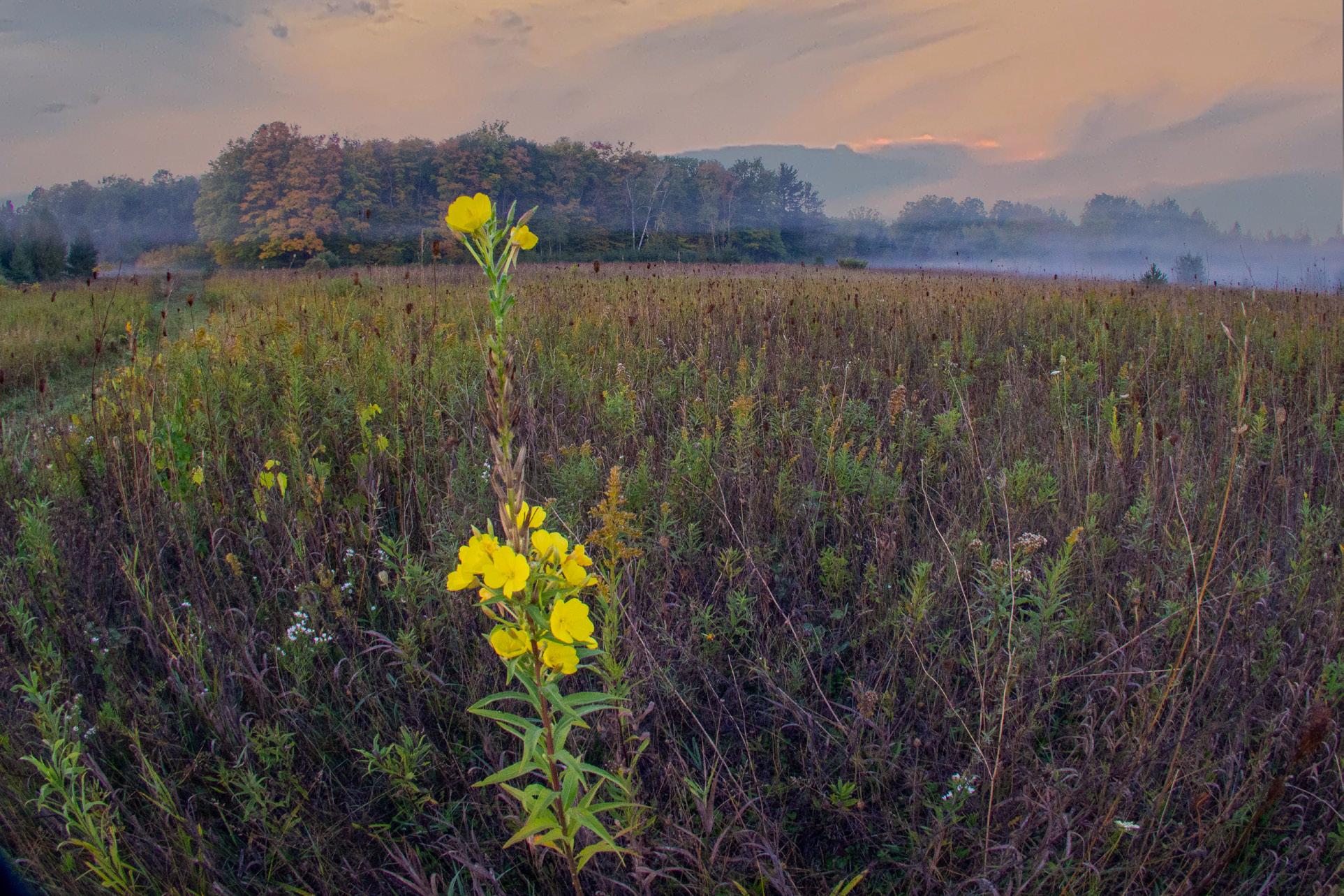
David Heilman receives top honors in this quarter’s Landings News Splash Photo Contest for the DCLT Photo Group. David used a Sony A7RV camera with a Canon FD 7.5mm circular fisheye lens to capture this scene at Oak Road Nature Preserve. This is how David describes his inspiration: “When I got up that morning and saw the ground fog, I got to Oak Road as quickly as possible because that is one of my favorite preserves for those kind of conditions.”
Door County Land Trust relies on photos submitted by the community for its publications. If interested in joining the DCLT Photo Group, or submitting a photo for publication, please email Communications Coordinator Kay McKinley at kmckinley@doorcountylandtrust.org.
Dear Door County friends,
You might enjoy Door County for its rural and rustic scenic views, its lightly traveled walking trails, and its distance from the hustle and bustle of life beyond its shores. It is a place where the sounds of nature resonate more loudly; a place where the wonders of nature tug at the soul, inviting exploration and curiosity for the great outdoors.
Among the lands protected by Door County Land Trust, there is so much life and biodiversity found here, and nowhere else. The county’s wetlands and fens are home to a plethora of rare orchids, plants, and endangered Hine’s emerald dragonflies. Remnants of arctic boreal forest habitats hug the shorelines. Arctic birds spend their winters here; hundreds of species of birds from Central and South America migrate here for the summer. Door County is a place where life thrives year round.
Protecting Door County’s lands and waters from unsuitable development is paramount to preserving the uniqueness of the Door Peninsula, its islands, and surrounding waters. Protecting the landscapes around us also solves so many issues that impact the quality of life here: clean air and drinking water, scenic beauty, rural and historic preservation, access to public lands and recreation, abundant fish and wildlife, and satisfaction in knowing we’ve done all we can to preserve Door County today and for future generations.
Conservation successes across Door County are thanks to donations from people like you, who care about the future of this place. Contributions from countless people help to fund the Door County Land Trust’s mission.
Door County Land Trust is grassroots in every sense of the word. The Land Trust is only able to protect land through the support of donations from people

who care about what makes Door County special— its wild places.
If you’ve not yet contributed to the effort to protect Door County, please consider donating today. As a new member of the Land Trust, your donation will be matched, dollar for dollar, with a generous challenge donation. (Find out how your gift is matched on page 7.)
If you’ve contributed in the past, please renew your membership or make a special end-of-year gift to help in the mission to protect Door County’s exceptional lands and waters.
Conserving the best of Door County—its scenic and rural beauty, its ecological diversity, its wilderness forests, coastal wetlands, and more—cannot wait for the next generation. It is our obligation and our privilege to protect these places now so that future generations inherit an earth filled with natural wonders, beauty, and a diversity of plants, animals, insects, birds, and more.
Join the effort today. You will make a world of difference for the future.

Emily Wood Executive Director

The work of the Door County Land Trust (DCLT) is more closely explained as finding the proper connecting pieces in a jigsaw puzzle rather than collecting properties in a Monopoly game. Protecting wilderness corridors that offer the greatest benefit to wildlife and the environment means choosing land protection projects that fit into the Land Trust’s detailed conservation puzzle.
DCLT’s land protection efforts align with larger conservation habitat restoration goals too. Door County is, after all, an interconnected piece of the Great Lakes ecosystem, one leg of North America’s migratory bird flyway.
DCLT’s conservation work aligns with regional and global efforts to protect water quality, rare and threatened species, wildlife habitat, forests, and more. Conservation plans by the Great Lakes Restoration Initiative, North American Wetlands Conservation Act, and the Fox River and Green Bay Natural Resources Trustees all rely upon DCLTs land protection work to fulfill larger regional strategies. When considering a property for protection, natural features of highest priority, or conservation targets, guide Land Trust decision-making. Among them are migratory bird habitat, surface water habitat (fisheries), Niagara Escarpment, and native boreal forest.
water is of great concern. The Land Trust does not target areas for the protection of drinking water, but the benefit of having clean water is a byproduct of the areas that are preserved. “Most of the land that we identify has water in it,” Koyen says. “It’s either surface water or a wetland—and protecting conservation targets directly impacts ground water and drinking water.”
“Within the next 5 to 15 years is the last best chance the Land Trust has to protect more diverse, less impacted, rare kinds of habitat before it’s all chopped up into little pieces and is
lost to development.” - Jesse Koyen, Land Program Director
Koyen says there is an urgency to protect designated Door County properties as many contain habitats that are considered rare on a regional, national, and global scale. Of particular importance are undeveloped areas that are still ecologically intact. These are places that Koyen says the Land Trust is “rushing to protect.”
“Within the next 5 to 15 years is the last best chance the Land Trust has to protect more diverse, less impacted, rare kinds of habitat before it’s all chopped up into little pieces and is lost to development,” he says.
One of the keys to permanent protection is to adjoin protected properties to create wildlife corridors and larger conserved landscapes. Whether talking about plants or animals, these connected pieces allow for movement and spread. This ensures that if one of the areas in the landscape is compromised ecologically, the corridor itself will remain protected.
“If we protect the rare species within these properties, we protect the system overall,” says Jesse Koyen, Land Program Director. Koyen likens this to the “canary in the coal mine” principle. “If a targeted species is thriving, it indicates that the ecosystem is in good shape as well,” he says.
Due to the diversity of land and habitat types across the peninsula, multiple conservation targets may be found within a single property. This layered approach to conservation planning results in benefits to the community that may not be readily apparent. For instance, within Door County the quality of drinking
Koyen sums up the work of the Door County Land Trust in this way: “Because we live within this rare, ecologically significant landscape, we have a global responsibility to protect biodiversity here. DCLT’s efforts are focused on not only safeguarding the lands and waters we already steward, but adding to those landscapes so that they are resilient to change.”

Read on to discover how the Land Trust is protecting the peninsula’s special environments through their nature preserves.

On a radiant, late September afternoon, the panoramic landscape of Bay Shore Blufflands Nature Preserve fans out before visitors. The view of the bluffs and fields is accented with strokes of red and gold in changing leaves. A light breeze lifts the heads of bronze grasses and tugs at the fluffy parachutes of milkweed seeds bursting from their pods.
From 1995-2015, the Land Trust pieced together 43 parcels that make up the 273-acre Bay Shore Blufflands Nature Preserve. When purchased, the land was a patchwork of escarpment, forests, and areas cleared for timber, farms, resorts, and a golf course. Today, the land has been restored to form a sizeable area of united, biodiverse environments that make the preserve resistant to negative ecological impact. Among these areas is the conservation target of the Niagara Escarpment and its undisturbed habitats.
From 1995-2015, the Land Trust pieced together 43 parcels that make up Bay Shore Blufflands Nature Preserve. Its biodiversity and size make it more resistant to negative ecological impact.
Monarch butterflies make the fields of Bay Shore Blufflands Nature Preserve a stop on their annual 3,000-mile journey from the northeastern United States and Canada to southwest Mexico. Monarch caterpillars feed only on milkweed and the butterflies lay their eggs on the plant. As pollinators, monarchs are essential for many ecosystems along the migration route to thrive. Monarchs are threatened by pesticides, the climate crisis, loss of U.S. grasslands, and illegal logging of the forests where they migrate for the winter. The protection of their habitat is especially important as Wisconsin is in the core breeding ground for the eastern migratory population of monarchs.
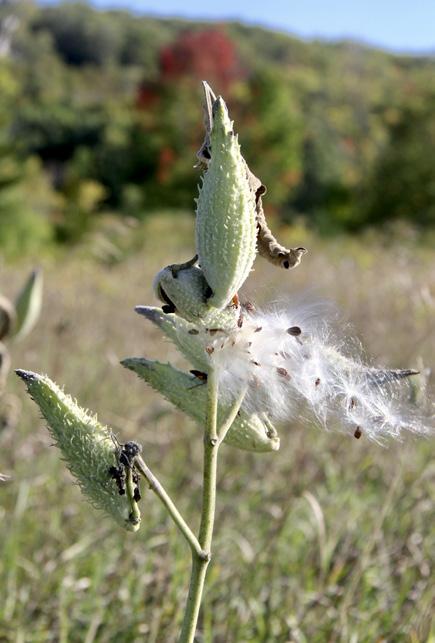
The preserve’s 2.5-mile hiking trail winds through fields, hardwood groves, and a dark mixed-conifer forest before climbing along the craggy, cool face of Niagara Escarpment bluffs. Midway along the trail, a hiker is treated to sweeping views of the waters of Green Bay below.
The damp crevices, rocky slopes and forested ridges of the escarpment are home to many rare species of plants and animals, including ancient land snails. Eight species of orchids also reside here.
In the spring, the preserve’s fields and forests provide food for migrating and breeding birds in the form of insects and nectar from blooming trees. In the fall, there are trees that bear fruit that nourish birds on their return trip to points south. The trees and thick shrubs throughout the preserve also provide protection from weather and predators.
The preserve’s wetlands and springs, which are not visible from the hiking trail, provide yet another habitat for insects and waterfowl, and wetland birds such as the Sandhill Crane.

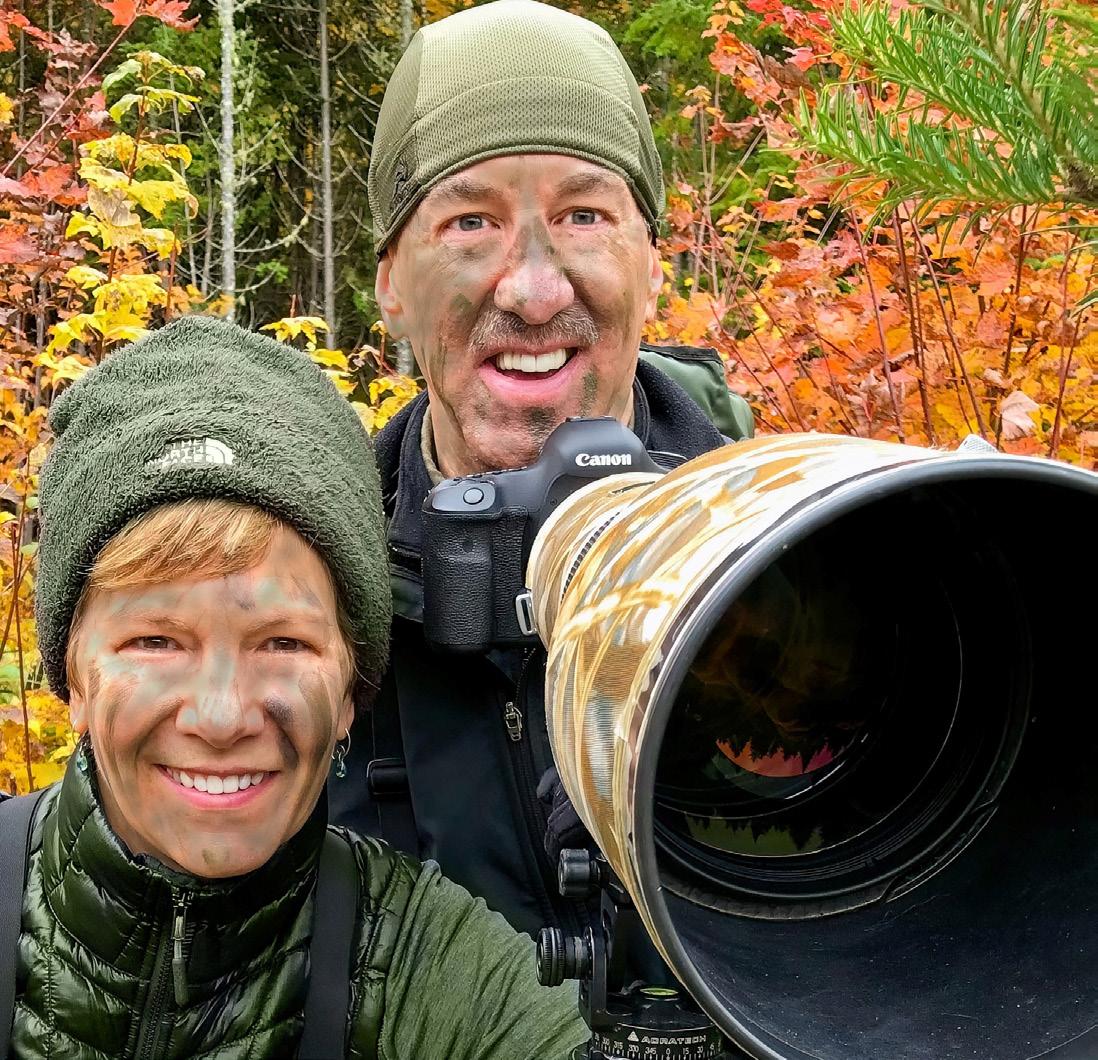
JThe Van Den Brandts each had traditional careers, Jean as VP of marketing at Secura Insurance and John as senior account manager at 4imprint in Oshkosh. His extraordinary wildlife images gained national attention after the company began publishing them in calendars. By 2007, the couple formed their own wildlife photography company, Wild Wind Images (wildwindimages.com).
ohn and Jean Van Den Brandt have many places to compare the wild spaces of Door County to when they say that they love the peninsula more than any other place on earth. The celebrated wildlife photographer and his wife and field assistant, Jean, have visited some of the most remote landscapes on the planet—hundreds of miles from a road and within yards of wildlife in their habitat untouched by man.
“We’ve been privileged to witness the most stunning spectacles of nature—from zebras crashing across the Mara River in Africa, to polar bears stalking in the Arctic, but we feel the most soul-stirring and wondrous moments have been in Door County,” Jean says. “You can get up close to the Escarpment where the moss is growing on rocks. You’re smelling it, you can reach out and feel it. Birds are flying around, and the water is crashing on the shore. We feel like we are enveloped in nature in Door County.”
The Van Den Brandts’ attachment to Door County began as children growing up in Wisconsin, when their respective families vacationed regularly on the peninsula. When the couple met in 1998, their combined appreciation of nature eventually led to both a personal and professional partnership, with frequent visits to Door County, including their wedding and honeymoon in 2002.
The couple’s concern for the protection of nature for future generations is focused on the Door County peninsula. The pair recently presented the idea of a matching gift challenge to inspire more people to join the Land Trust’s efforts.
“I think anyone who loves Door County at some point has that moment where they have that
little bit of apprehension thinking about what this will be like 50 years from now, or beyond,” John says. “We think that this is the time to consider doing something that is more than just making a gift or contribution. It’s an investment in the future of Door County.
The challenge works in this way: For each person who makes a first-time donation before the end of 2023, the Van Den Brandts will match the gift dollar for dollar, up to $40,000. Secure donations may be made by visiting www.DoorCountyLandTrust.org/ LandChallenge.
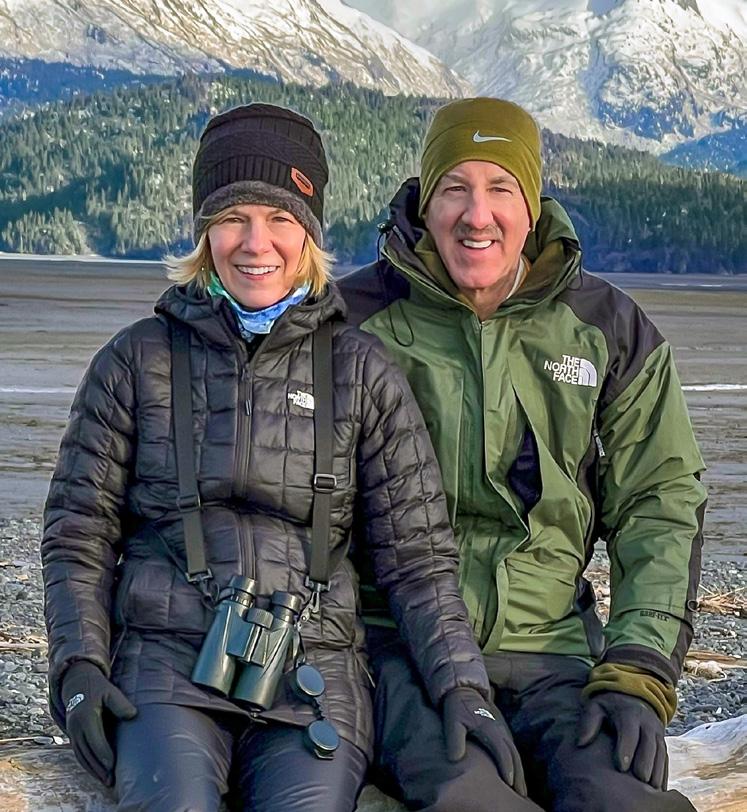
The
Alaska
“We think it’s crucial that it [the Land Aquisition Fund] gets replenished so that the Land Trust can seize further opportunities when critical habitat becomes available.”
- John and Jean Van Den Brandt
Witnessing the Land Trust’s recent, swift purchase of ecologically important land through the Land Acquisition Fund inspired the couple to make efforts now to replenish the fund’s coffers. “The Land Acquisition Fund was used this year with great benefit and results,” John said.
“We think it’s crucial that it gets replenished so that the Land Trust can seize future opportunities when critical habitat suddenly becomes available. The window of opportunity to purchase and protect those keystone parcels of land might only be once in our lifetime, so a robust land acquisition fund will enable the Land Trust to respond to those opportunities when they arise. Giving to this isn’t so much an obligation as it is a privilege.”
Your gift to protect the best of Door County for the next generation cannot wait.
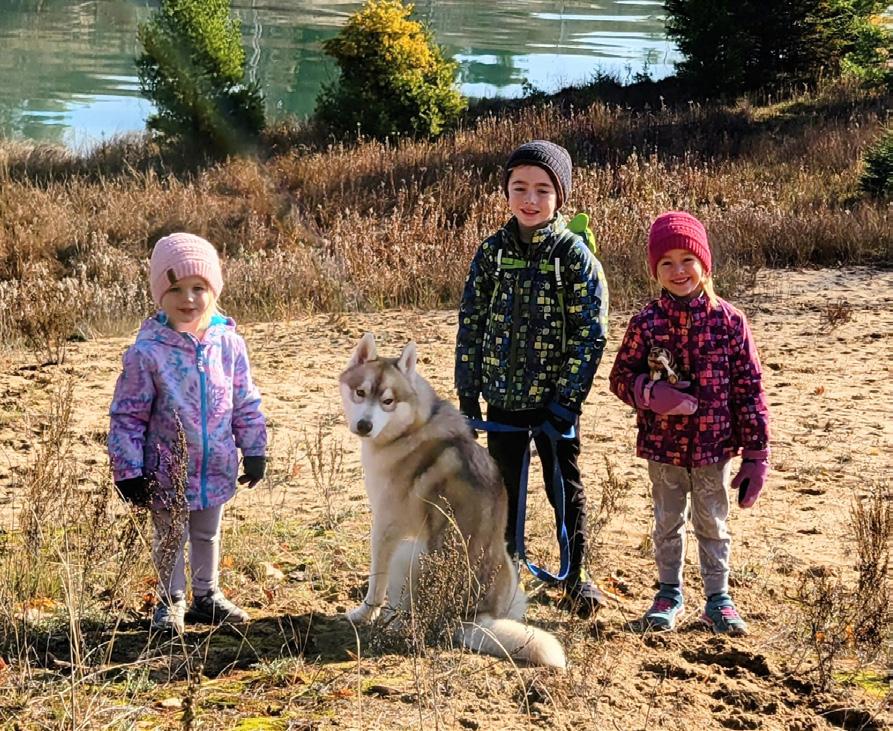
Photo by Jillian Laurent
Your gift today helps protect the exceptional lands and waters of Door County...forever. It is an OBLIGATION and PRIVILEGE for all of us to protect these places NOW.
You can help so that future generations inherit an earth that you’ve been able to enjoy—a home that sustains life. It’s an earth filled with natural wonders, beauty, and a diversity of plants and animals.
Your donation not only promises a future of protected lands and waters, but their care, and the ability to keep Door County trails open and free to everyone, 365 days of the year.
If you’ve not yet contributed to the effort to protect Door County, please consider donating today. As a new member of the Land Trust, your donation will be matched, dollar for dollar, with a generous challenge donation. (Find out how your gift is matched on page 7.)
If you’ve contributed in the past, please renew your membership or make a special end-of-year gift to help in the mission to guarantee that the lands and waters of Door County remain special to future generations.
Your gift provides for a priceless legacy. If they could speak, Door County’s wild creatures would say,
“Thank you!”
To donate, please visit DoorCountyLandTrust.org/Donate or use the QR code at right.

“Door County is a special and unique place that will be lost to development if we don’t protect it.”

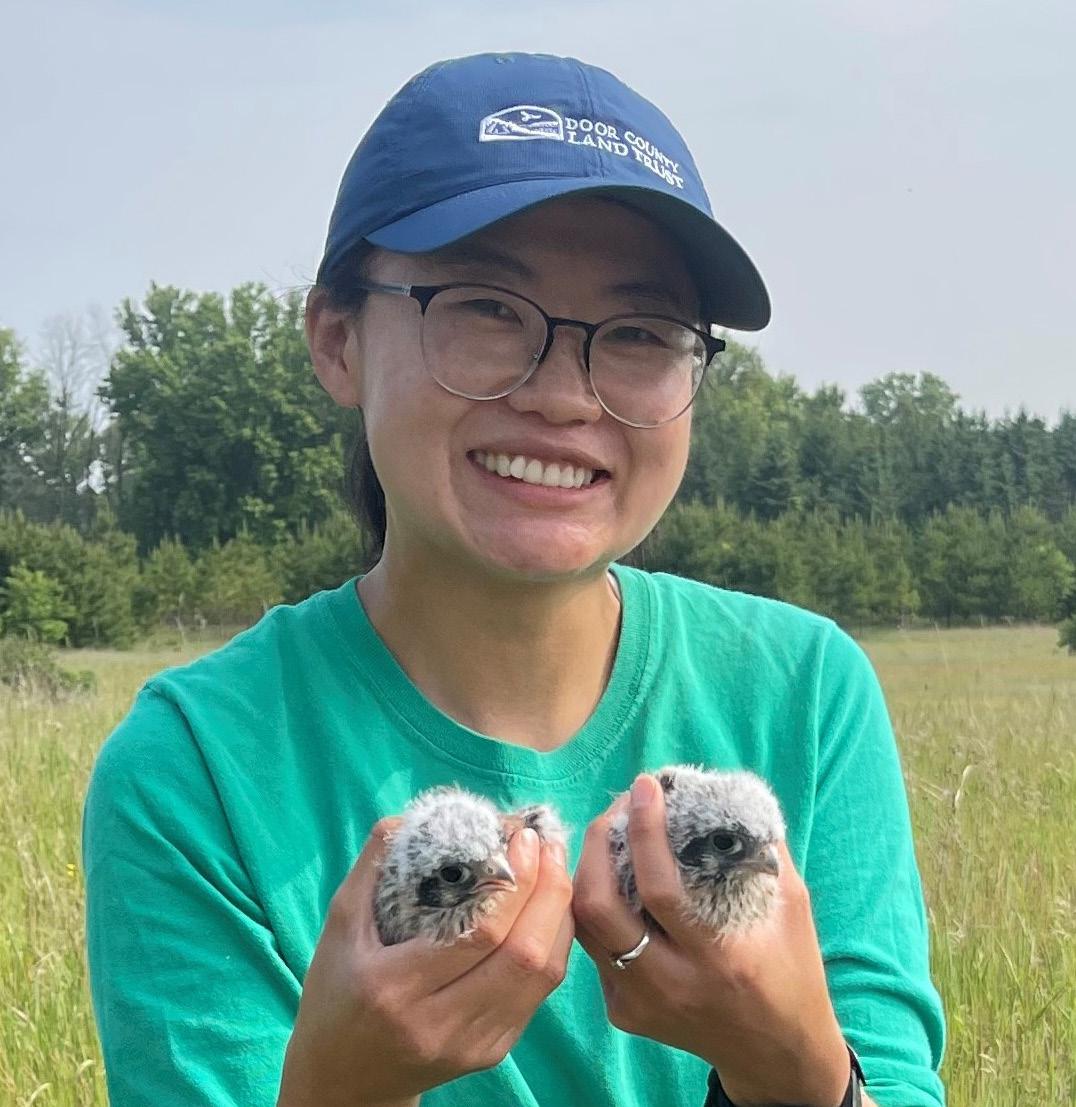

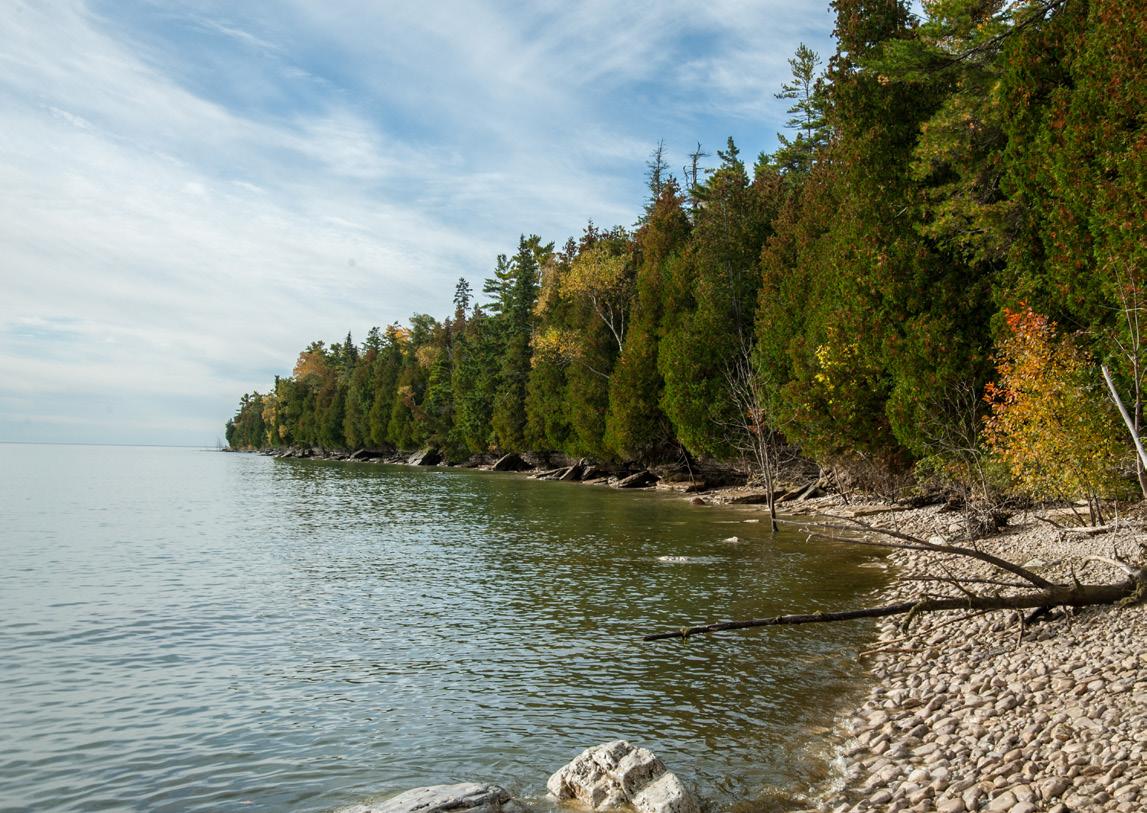
“People’s quality of life depends on the quality of our land, air and water.”

“The power of a group of commited individuals can save our natural world.”

“When we help nature, we help ourselves.”


How
would YOU fill in the blank?
“Door County Land Trust matters to me because I believe…”

“Our children and our children’s children deserve a healthy planet.”
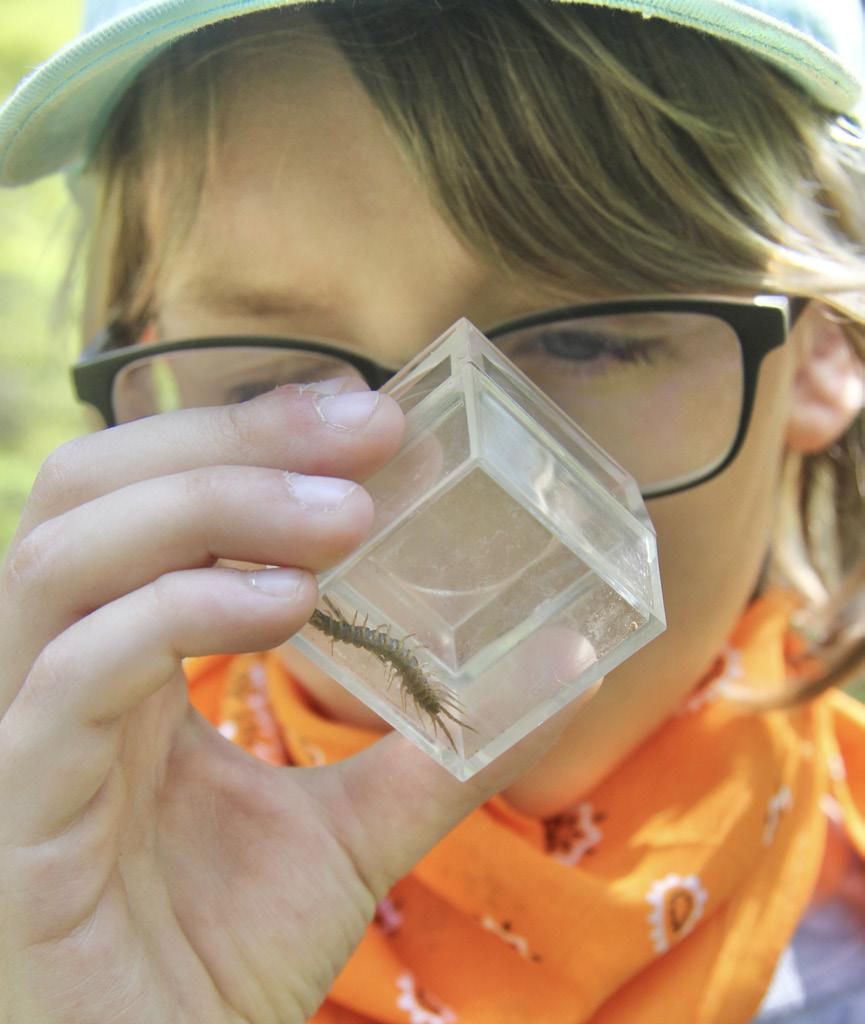


“The world is our home, we must protect it for life to survive.”

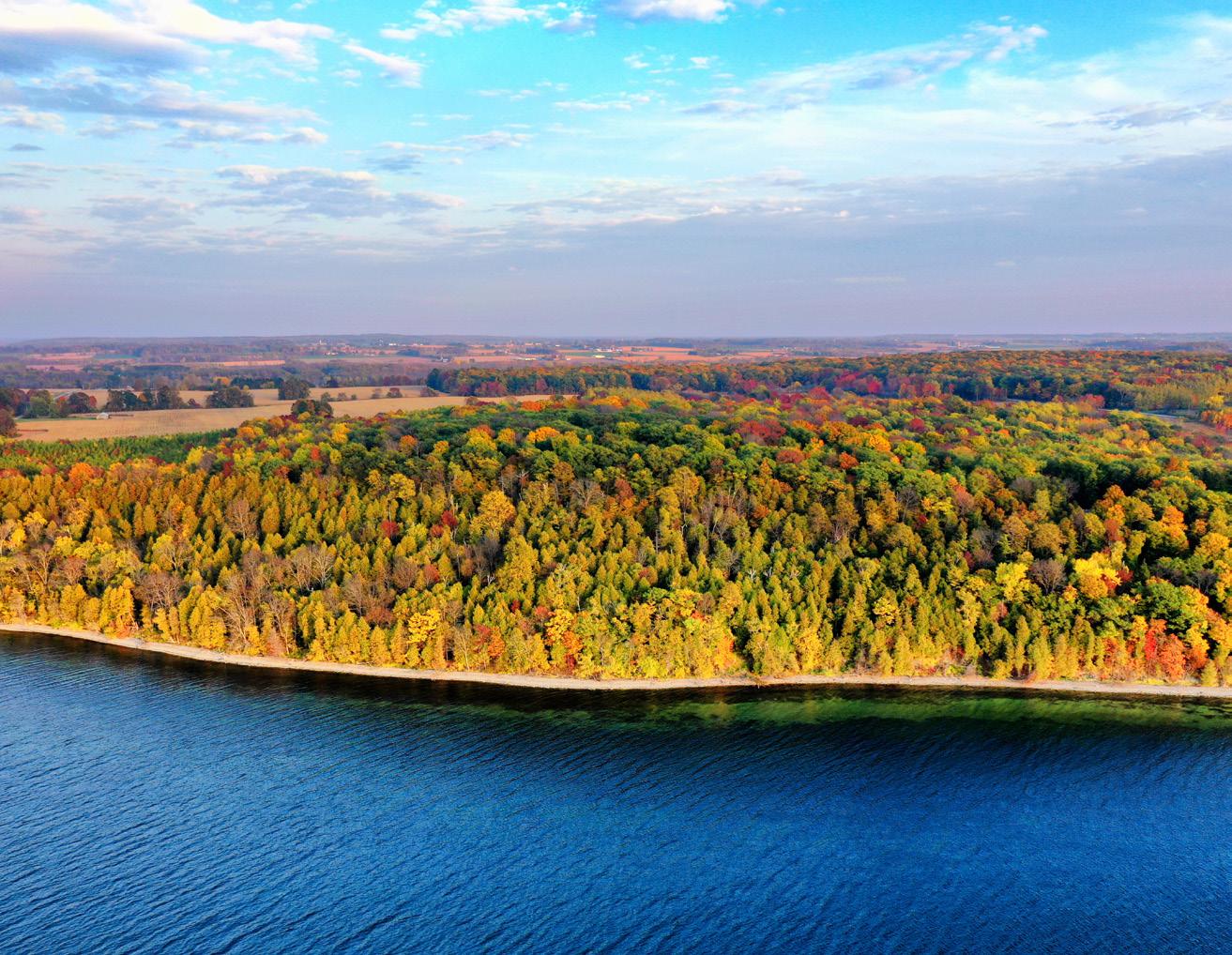

Abreak in the rain prompts a hike at Three Springs Nature Preserve. With pine needles underfoot, and silvery raindrops clinging to flat cedar needles and spider webs, the walk along the forested path gains a soundtrack with the calls and trills of Pine Warblers, American Crows, and Purple Finch.
Further exploration of the preserve demonstrates why there is an avian chorus: The native forest habitat is a conservation target that caters to breeding birds.
As the trail continues, more environmental conditions support these birds’ well-being. The path opens onto an expansive field of grasses and shrubs, continues through a plantation of towering pines, then comes to a clearing that reveals the rustic remnants of a former 1883 homestead. But at 515 acres, there is more to this preserve. The trail has a dramatic finish—a view

of wetlands and springs that empty into a pond that reflects the surrounding landscape.
Here, at the southern-most point of the northern hemisphere’s boreal forest (a cool, damp forest that ranges from the Arctic Circle through Door County), native forests sustain many wildlife and plant species. The Purple Finch is one of many species of breeding birds that call the preserve its year-round home.
Purple Finch populations decreased by 32% between 1966 and 2019 due to habitat loss through development and competition with the look-alike House Finch. The protection of native forests is crucial to their survival.
In summer, Purple Finches favor boreal forests or mixed forests that are along wooded streams. In winter, their habitat expands to include shrubby areas, weedy fields, and hedgerows.


Purple Finch nests can be spotted far out on the limb of a coniferous or hardwood tree with an overhanging branch for shelter. Nests range from 2.5 feet up to 60 feet off the ground. This preserve’s trees provide Purple Finches with their preferred, high treetop vantage point to stage their warbling song.
Purple Finch populations decreased by 32% between 1966 and 2019 due to habitat loss through development and competition with the look-alike House Finch. The protection of native forests is crucial to their survival.
for Purple Finches. Their diet includes seeds of coniferous and deciduous trees, soft buds, nectar, berries, and fruit.
In winter, you may see Purple Finches eating the seeds of low plants like dandelions. They eat some insects, including aphids, caterpillars, grasshoppers, and beetles. Like many of the Land Trust’s nature preserves, Three Springs contains several conservation target habitats. Three Springs’ wetlands protect many rare and endangered plants and animals, and they have a direct effect on the quality of the land and waters downstream. Even the homestead’s timber and limestone barn serves an important environmental purpose—it’s a maternity roost for little brown bats. The preserve lies within 11,400 acres of land protected by Door County conservation partners. Named by the International Ramsar Convention on Wetlands as the “Door Peninsula Coastal Wetlands,” it is recognized by conservationists for its outstanding ecological qualities of global importance.
Reaching the top of a short embankment covered in purple-bronze and yellow ferns, the view of Heins Creek Nature Preserve reveals a rolling landscape. Late afternoon shadows seem to deepen the dips of sand dunes scattered about a grassland dotted with sturdy hemlock evergreen trees and yellow birch with leaves turning to gold. A look to the right provides the clue to the location of Heins Creek. Rimmed in ferns, pine, and hemlocks, a hidden dirt path meanders along the creek and cedar swamp. In the spring and summer, Heins Creek provides a spawning place for rainbow trout and suckers. Due to lack of rain, today the muddy creek bed holds only puddles of water.
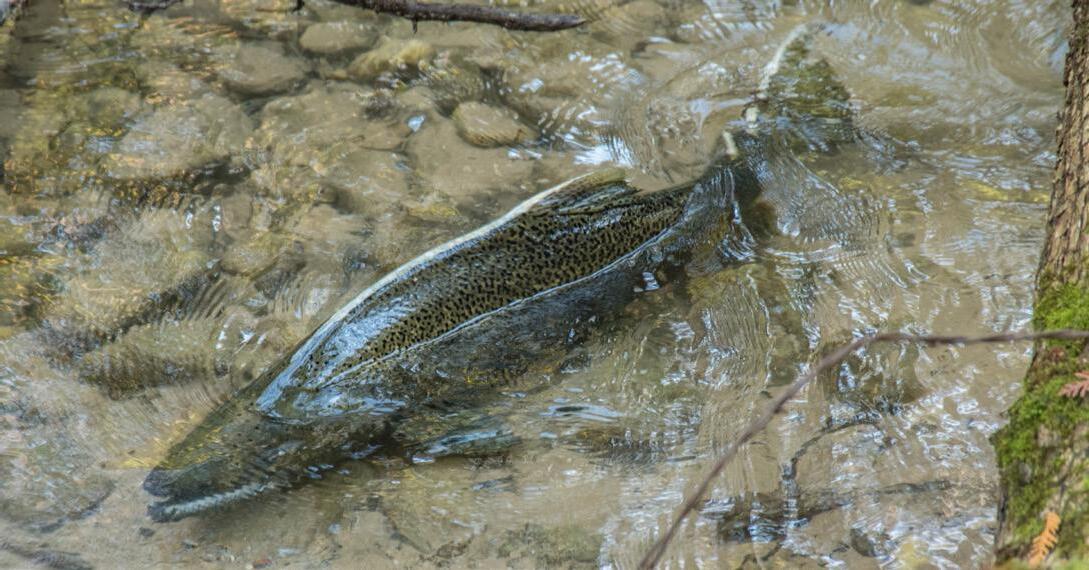
Among the conservation targets located at Heins Creek Nature Preserve is clean surface water for fishery habitat.
Among the conservation targets located at Heins Creek Nature Preserve is clean surface water for fishery habitat. This is made possible by land protection that promotes the habitat conditions that make fish in the stream possible. Successful springtime spawning of both suckers and rainbow trout requires specific factors, including coarse sediment (to ensure an adequate flow of oxygen to the eggs during incubation), a temperature of around 50 degrees Fahrenheit, clean water, and dissolved oxygen. Healthy fish habitat in turn benefits wildlife in surrounding environments as fish provide food for birds and mammals and balance insect populations.

As one body of water flows into another, its water quality affects that of connected waters. Heins Creek moves the waters of Kangaroo Lake through the preserve to connect with Lake Michigan. This system satisfies the water habitats needed for the entire life cycle of suckers and rainbow trout.
Suckers can spawn naturally, but rainbow trout need more encouragement through the Wisconsin Department of Natural Resources (WI-DNR) fish stocking program.
Stemming from the Great Lakes rehabilitation effort in the 1960s, half-a-million rainbow trout are stocked annually in Lake Michigan. Before arriving to spawn in Heins Creek, the journey for these trout is long. It begins with WI-DNR collecting adult brood stock in the Kewaunee and Root Rivers. The fish are then transported to Kettle Moraine Springs State Fish Hatchery where they are raised to yearling size for stocking in streams along the Lake Michigan shoreline. Once in Lake Michigan, rainbow trout feed on small fish, insects, and crayfish. They typically move along the shore up to 50 miles from their place of stocking.
When they mature in two to four years, they return to their stocking location to spawn. After spawning, they venture back to Lake Michigan to recover and continue their growth. The cycle is repeated on a yearly basis.
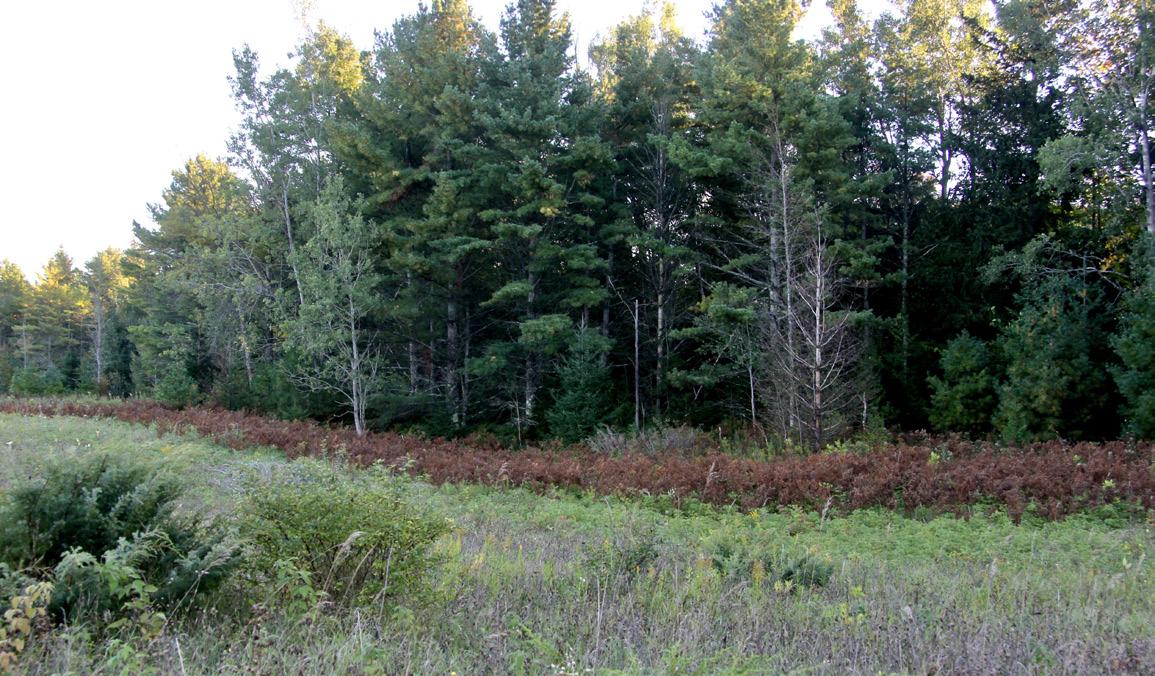
by
Asense of adventure accompanies a journey to Little Lake Nature Preserve on Washington Island. A meandering path leads to its discovery, placing visitors between a golden farm field and a moss-covered, chunky rock wall. The entrance to the 32-acre preserve is marked with tall white cedar and hemlock trees that border a cobblestone trail scattered with cedar needles.
A treasured view is just ahead on a 150-foot wide isthmus that separates the still, shallow waters of Little Lake to the east and the waves of Lake Michigan directly to the west This scene reveals an environment that aligns perfectly with the conservation target of mirgratory bird habitat, namely a forested area close to water.
Little Lake Nature Preserve encompasses the entire northern half of Little Lake, including over 5,000 feet of shoreline.
Door County is located on the northern portion of the Mississippi Flyway, one of four major bird migration routes in North America. “Along the shores of Lake Michigan, forests are more diverse, leading to more variety in plant and insect species in a short range that provide migratory birds food and shelter,” says Jesse Koyen, Land Program Director. “Migratory birds follow Lake Michigan waterways, staying close to the edge of land and water. The interaction with water means there are plenty of insects.”
night, the dark night sky of the island welcomes them without the confusion of an abundance of man-made light to take them off course.
Little Lake Nature Preserve provides important resources for waterfowl, birds of prey, and songbirds, like the Blackburnian Warbler. The Blackburnian Warbler feeds primarily on insects.
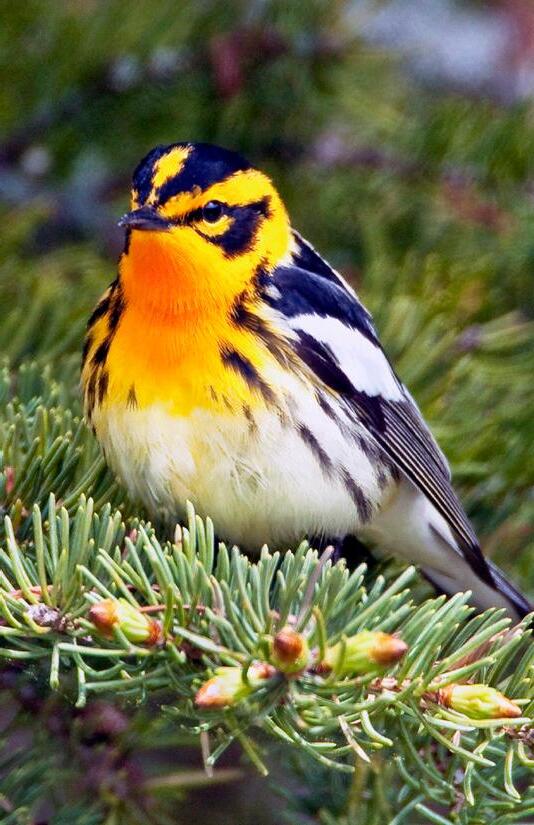
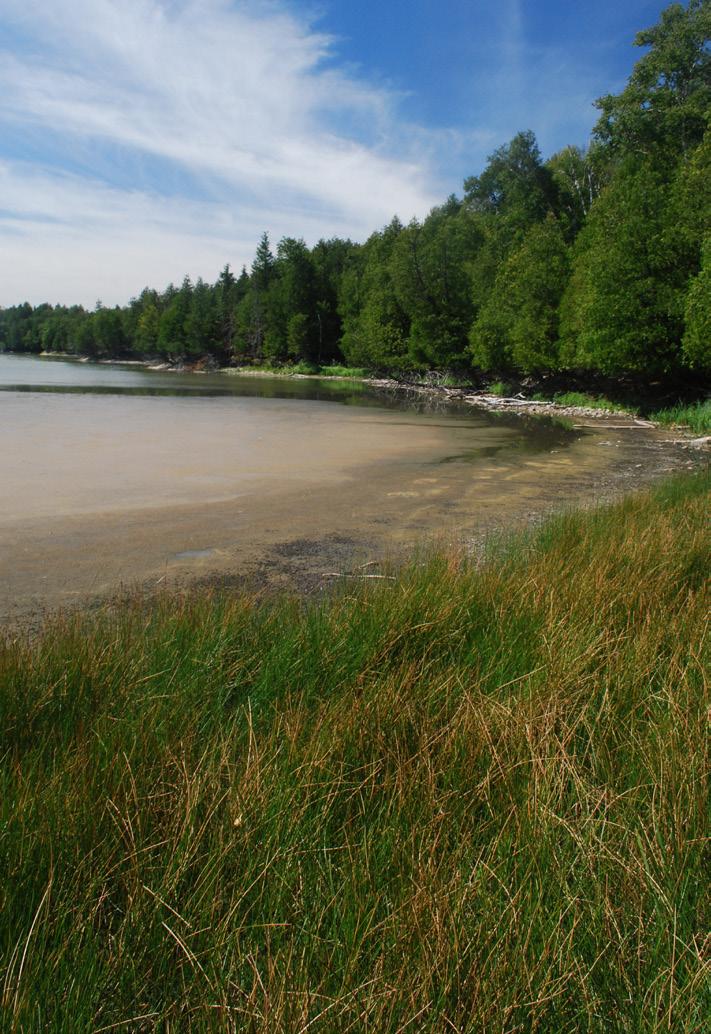

The environment of Little Lake aligns perfectly with the conservation target of serving migratory birds.
Washington Island itself is a rare haven for transient birds as its forests and fields are encircled by water. Because migratory birds fly to their destinations at
Feeding in treetops, they will hover to find insects on the underside or tips of leaves. Sometimes this warbler will take to the air away from vegetation to catch flying insects. Its diet includes caterpillars, beetles, ants, flies, and spiders.
Warblers summering on Washington Island will most often place their nests high above the ground near tips of conifer branches where the cover is dense. Nests are made of twigs, bark, and fibers and lined with lichens, moss, grass, hair, and conifer needles.
Migrating birds, like the Blackburnian Warbler, provide many ecological benefits during their long-range travel. They feed on insects and other organisms that harm agriculture, they disperse seeds that contribute to biodiversity, and their nitrogen-rich droppings act as organic fertilizer. Eggshells can also add calcium and other minerals to the soil.

Photos by Kay McKinley
It’s like someone switches on a light: dark gray snow clouds suddenly part to spread the sparkle of sunshine over the lakeshore, ridges, and swales of Sturgeon Bay Ship Canal Nature Preserve. And just as quickly, the short walk up the snow-covered boardwalk reveals centuries of an evolving landscape. The Ship Canal ridge and swale landscape is just as rare globally as it is along the Great Lakes. The formation of the preserve’s twenty-three ridges began thousands of years ago, after receding glaciers and lake currents formed the shore of Lake Michigan along Door County’s eastern edge. The movement of deposited sediment and varying height of the lake through time created a series of ridges and damp swales—all within steps of each other—with distinct habitats for flora and fauna. Each ridge represents a former beach line of Lake Michigan. The further one walks inland from the beach, the denser the vegetation due to succeeding ridges

that provide natural buffers to wind and water. The furthest habitat is that of a boreal forest with balsam fir and white spruce. The Ship Canal boreal forest is associated with the northern forests near Lake Superior. This type of forest is important for carbon storage and filtration for clean water. The youngest ridge closest to the lake began forming in the late 1800s. Its dune habitat is home to the Pitcher’s dune thistle, a rare plant that is crucial to pollinator survival and the continuation of other plant species. In between these ridges are areas with bog vegetation, mixed coniferous-hardwood forest, alder thickets, sedge meadows, and coastal marshes.
Finding so many diverse habitats of varying ages within this one preserve is even more unique due to the number of rare plants and animals that call the site home. The wildlife includes over sixty species of breeding birds, including numerous threatened and endangered species. Among the plant life are rare species of orchids and club mosses.
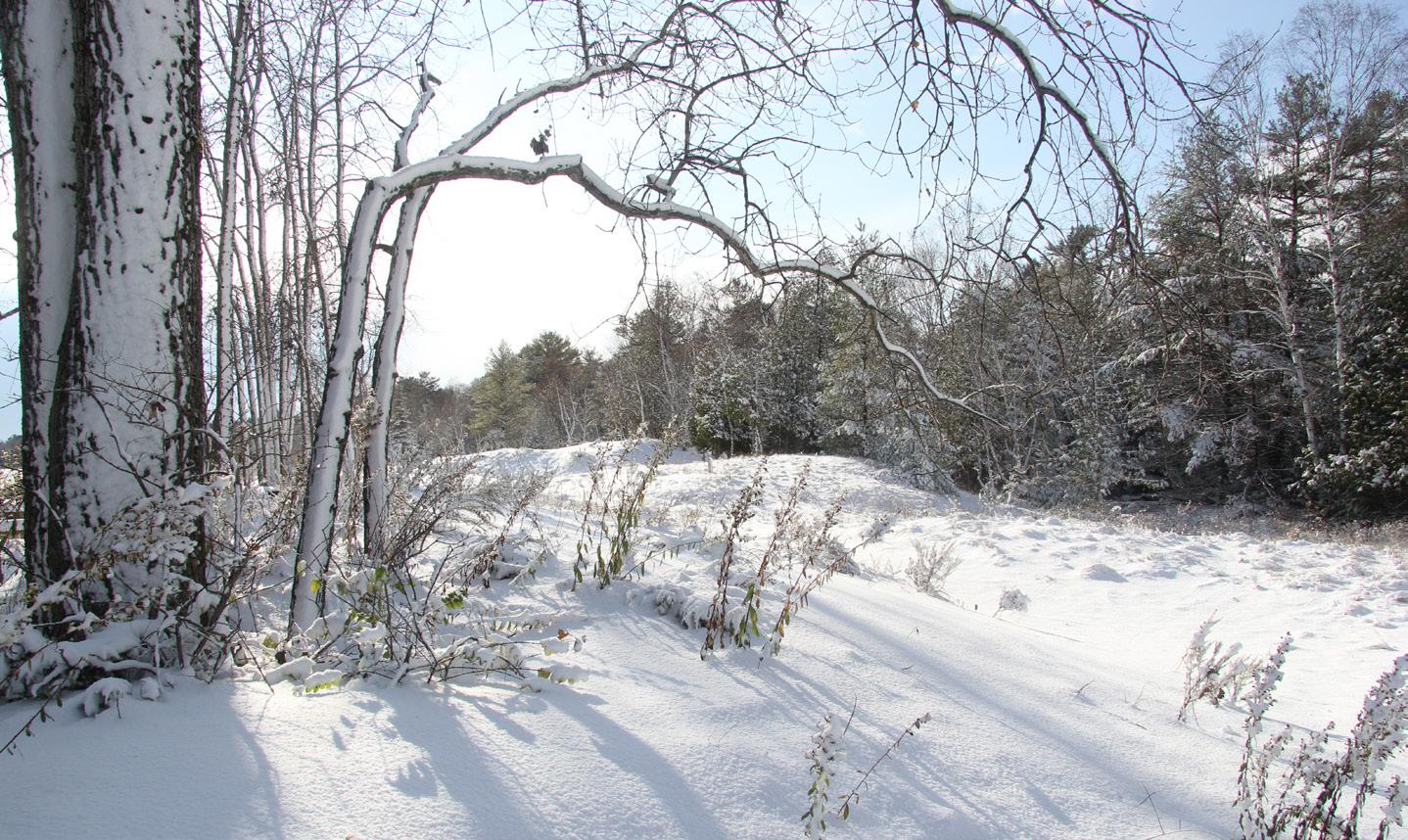

Asudden storm of heavy, wet snow frosts tree branches, fields, and bluffs of the newly purchased property that will become Door County Land Trust’s (DCLT) Bear Creek Nature Preserve. The snow enhances its scenic appeal, highlighting the bones of a diverse landscape. It’s been a decade since DCLT added a property slated to join the roster of its current 14 preserves. But this 75 acres located in the Town of Clay Banks is no ordinary piece of land.
Land Program Director Jesse Koyen has only enthusiasm for what this new addition will bring to Southern Door and DCLT’s protected lands overall.
“It’s just beautiful,” Koyen says. “You go for a walk and see this topography—the bluffs, dramatic vistas of open land, ancient 50-foot stream banks, the native forest. It’s just a unique property and you have Bear Creek flowing through the heart of it; a perennial stream that is of great water quality. It supports cold water fish, which is becoming less and less common with the changing landscape and climate. It’s an exciting property to protect.”
The former dairy farm features .6 miles of Bear Creek, which contains rainbow trout. The ability to meet the conservation target of healthy fish habitat is no small victory for what it says about water quality overall. Early staff visits to the creek revealed plentiful populations of macroinvertebrates like stone flies, caddis flies, and crane flies. These insects are ideal nourishment for fish and indicate good water quality.
In addition to the creek, the land is only a half mile from Lake Michigan, offering a stopover for migratory birds. Of note is a sighting on the property of a pair of songbirds that are a species of Special Concern in the

State of Wisconsin. Grassland breeding birds and native pollinators will also find a home in the existing fields.
For now, Koyen says the general stewardship plan for the property is to restore agriculture fields to grasslands and expand the forest with tree planting.
When DCLT chooses land for a preserve it means striking a balance between protecting wildlife habitat while allowing access to visitors that doesn’t interfere with the ecology. The topography of the future preserve has more upland than wetland, providing a less complicated infrastructure base with the ability to provide visitor access year round.
“There will be a little area where we’ll have to do some boardwalks to cross the creek and wetlands, but for the most part, we’ll convert some old farm roads into pedestrian trails,” Jesse said.
Koyen is in hopes that Bear Creek Nature Preserve will be able to welcome visitors as soon as this coming year with a parking lot and a simple trail. He believes that with the proper planning, infrastructure, and funding the preserve should be completed sometime in 2025, and will include ADA-accessible trails where possible.
Friday, December 1st
7:00 PM – 8:30 PM
Night Exploration Hike
Solitude Natural Area, north of Jacksonport
Join us for a special night adventure at the Door County Land Trust’s Solitude Natural Area. This is an opportunity to discover some of the nocturnal animals that call the preserve home and learn about the adaptations nocturnal animals use to survive.
Free, Open to all
Limit: 18 Registered Participants
Hike leaders:
Terrie Cooper
Gretchen Schmelzer
Friday, January 26th
7:00 – 8:30 PM
Walk When the Moon is (Almost) Full
Location TBD
Join us for a night hike adventure lit by the moon a night after the January full moon, known as the Wolf Moon. This relatively flat terrain makes for wonderful winter walking or snowshoeing, if we should be so lucky!
Participants must provide their own snowshoes. Rentals available at Ecology Sports or Bay Shore Outfitters.
Free, Open to All Limit: 18 Registered Participants
Hike Leaders:
Gretchen Schmelzer Guy Fortin
Friday, February 23rd
7:00 – 8:30 PM
Walk When the Moon is (Almost) Full
Location TBD
Join us for a night hike adventure lit by the moon a night after the February full moon, known as the Snow Moon. Experience the magic and serenity of nature at night. This relatively flat terrain makes for wonderful winter walking or snowshoeing, if we should be so lucky!Trails are relatively flat, easy to traverse.
Participants must provide their own snowshoes. Rentals available at Ecology Sports or Bay Shore Outfitters.
Free, Open to All L imit: 18 Registered Participants
Hike Leaders: Marilyn Hansotia, Jack Finger
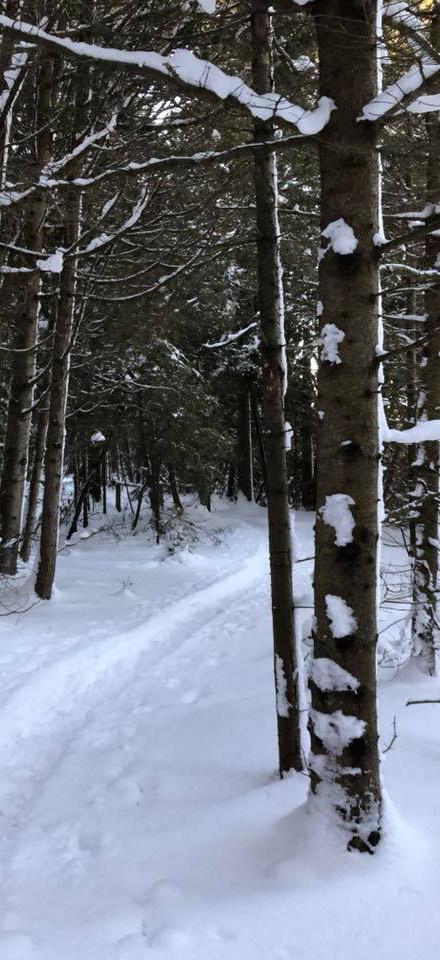




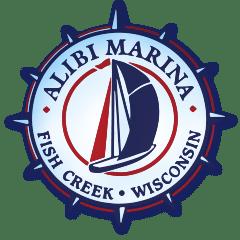






Protecting Door County’s E xceptional Lands and Waters...Forever
(920) 746-1359 • www.DoorCountyLandTrust.org
PO Box 65, Sturgeon Bay, WI 54235 Door Count y La nd Tr ust

Migratory birds connect people, ecosystems, and nations. They are symbols of peace and of an interconnected planet.
- Antonio Guterres, United Nations Secretary-General